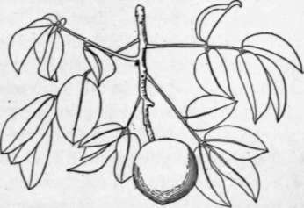From the Manual Of
Tropical And Subtropical Fruits
by Wilson Popenoe
The Imbu
Spondias tuberosa,
Arruda
Of the several fruits belonging to the genus Spondias which are
grown in various parts of the tropics, the imbu, although relatively
little known, is perhaps the best. It merits cultivation wherever
climate and soil are suited to its growth.
1 In Broteria, xiv, January, 1916.
2 Bull. 32, Philippine Bur. Agr., 1916.
The
imbu grows spontaneously upon the catingas or dry plains of
northeastern Brazil. Rarely is it cultivated, since the wild trees
furnish more fruit than can be consumed. It has been planted, however,
in a few localities where the wild trees are not found. It was
introduced into the United States in 1914, but so far as is known, has
not been planted in other countries. In view of its abundance in its
native home, it is strange that a fruit of such good quality should
have escaped the attention of horticulturists until very recently.
The
imbu tree is distinguishable from other growths on the catinga by its
low spreading crown, which is often 25 feet in diameter. The roots are
swollen (whence the specific name tuberosa), and are said by M. Pio
Correa to be used as food in times of scarcity. The leaves are 4 to 6
inches long, with five to nine oblong-ovate leaflets, equilateral or
nearly so, subserrate or entire, and from 1 to 1 3/4 inches in length.
The small white flowers are borne in panicles 4 to 6 inches long. Like
those of other species of Spondias, the flowers are composed of a calyx
having four or five segments and a corolla of four or five valvate
petals. The stamens are eight to ten in number, the styles three to
five.
The fruit is produced on slender stems, mainly toward the
ends of the branches. Some trees are so productive that the fruit, when
allowed to fall, forms a carpet of yellow upon the ground. In general
appearance the imbu may be likened to a Green Gage plum. It is oval,
about 1 1/2 inches in length, and greenish yellow in color. The skin is
thicker than that of a plum, and quite tough. The flavor of the soft,
melting, almost liquid flesh is suggestive of a sweet orange. If eaten
before it is fully ripe, the fruit is slightly acid. The seed is oblong
and about 3/4 inch in length.

Fig. 23. Fruiting twig of the imbu (Spondias
tuberosa). (X about 1/3)
In
its native home the imbu is eaten as a fresh fruit, and also furnishes
a popular jelly. It is used besides to make imbuzada, a famous dessert
of northern Brazil. This is prepared by adding the juice of the fruit
to boiled sweet milk. The mixture is greenish white in color and when
sweetened to taste is relished by nearly every one.
While the
tree is susceptible to frost, it cannot be considered strictly
tropical. In south Florida young plants have withstood temperatures of
28° above zero without serious injury. Little is known
regarding
its adaptability to various soils and alien climates. While the wild
trees are found on very dry soil in a region of little rainfall, it is
possible that other conditions will prove suitable. A few bearing trees
were seen by the writer in the city of Bahia, Brazil, where the
humidity is great and the annual rainfall about 60 inches. In south
Florida it has been tried at Miami, but has not done well. Its failure
there has been attributed to the large amount of lime contained in the
soil, but it is not certainly known that this is the limiting factor.
The soil on the Brazilian catingas is a gravelly loam, sometimes mixed
with clay, sometimes sandy.
Fruit from the wild trees varies in
size, color, and quality. It should be easy to propagate the best
seedlings by cuttings; at least, other species of Spondias are
propagated in this way. Mature wood is used. At Miami, Florida, the
imbu has been inarched on the ambarella. Seeds are easily induced to
grow, and should be germinated in flats or boxes of light soil.
Back to
Ambarella Page
Yellow Mombin Page
Purple Mombin Page
|
|